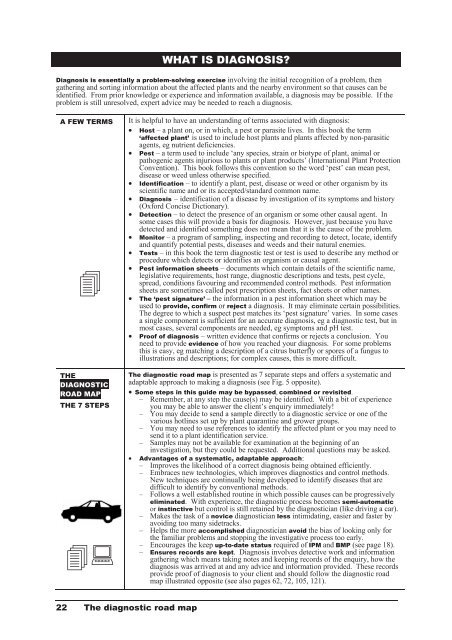PLANT PROTECTION 4
PLANT PROTECTION 4
PLANT PROTECTION 4
You also want an ePaper? Increase the reach of your titles
YUMPU automatically turns print PDFs into web optimized ePapers that Google loves.
22 The diagnostic road map<br />
WHAT IS DIAGNOSIS?<br />
Diagnosis is essentially a problem-solving exercise involving the initial recognition of a problem, then<br />
gathering and sorting information about the affected plants and the nearby environment so that causes can be<br />
identified. From prior knowledge or experience and information available, a diagnosis may be possible. If the<br />
problem is still unresolved, expert advice may be needed to reach a diagnosis.<br />
A FEW TERMS<br />
<br />
THE<br />
DIAGNOSTIC<br />
ROAD MAP<br />
THE 7 STEPS<br />
<br />
It is helpful to have an understanding of terms associated with diagnosis:<br />
Host – a plant on, or in which, a pest or parasite lives. In this book the term<br />
‘affected plant’ is used to include host plants and plants affected by non-parasitic<br />
agents, eg nutrient deficiencies.<br />
Pest – a term used to include ‘any species, strain or biotype of plant, animal or<br />
pathogenic agents injurious to plants or plant products’ (International Plant Protection<br />
Convention). This book follows this convention so the word ‘pest’ can mean pest,<br />
disease or weed unless otherwise specified.<br />
Identification – to identify a plant, pest, disease or weed or other organism by its<br />
scientific name and or its accepted/standard common name.<br />
Diagnosis – identification of a disease by investigation of its symptoms and history<br />
(Oxford Concise Dictionary).<br />
Detection – to detect the presence of an organism or some other causal agent. In<br />
some cases this will provide a basis for diagnosis. However, just because you have<br />
detected and identified something does not mean that it is the cause of the problem.<br />
Monitor – a program of sampling, inspecting and recording to detect, locate, identify<br />
and quantify potential pests, diseases and weeds and their natural enemies.<br />
Tests – in this book the term diagnostic test or test is used to describe any method or<br />
procedure which detects or identifies an organism or causal agent.<br />
Pest information sheets – documents which contain details of the scientific name,<br />
legislative requirements, host range, diagnostic descriptions and tests, pest cycle,<br />
spread, conditions favouring and recommended control methods. Pest information<br />
sheets are sometimes called pest prescription sheets, fact sheets or other names.<br />
The ‘pest signature’ – the information in a pest information sheet which may be<br />
used to provide, confirm or reject a diagnosis. It may eliminate certain possibilities.<br />
The degree to which a suspect pest matches its ‘pest signature’ varies. In some cases<br />
a single component is sufficient for an accurate diagnosis, eg a diagnostic test, but in<br />
most cases, several components are needed, eg symptoms and pH test.<br />
Proof of diagnosis – written evidence that confirms or rejects a conclusion. You<br />
need to provide evidence of how you reached your diagnosis. For some problems<br />
this is easy, eg matching a description of a citrus butterfly or spores of a fungus to<br />
illustrations and descriptions; for complex causes, this is more difficult.<br />
The diagnostic road map is presented as 7 separate steps and offers a systematic and<br />
adaptable approach to making a diagnosis (see Fig. 5 opposite).<br />
Some steps in this guide may be bypassed, combined or revisited.<br />
– Remember, at any step the cause(s) may be identified. With a bit of experience<br />
you may be able to answer the client’s enquiry immediately!<br />
– You may decide to send a sample directly to a diagnostic service or one of the<br />
various hotlines set up by plant quarantine and grower groups.<br />
– You may need to use references to identify the affected plant or you may need to<br />
send it to a plant identification service.<br />
– Samples may not be available for examination at the beginning of an<br />
investigation, but they could be requested. Additional questions may be asked.<br />
Advantages of a systematic, adaptable approach:<br />
– Improves the likelihood of a correct diagnosis being obtained efficiently.<br />
– Embraces new technologies, which improves diagnostics and control methods.<br />
New techniques are continually being developed to identify diseases that are<br />
difficult to identify by conventional methods.<br />
– Follows a well established routine in which possible causes can be progressively<br />
eliminated. With experience, the diagnostic process becomes semi-automatic<br />
or instinctive but control is still retained by the diagnostician (like driving a car).<br />
– Makes the task of a novice diagnostician less intimidating, easier and faster by<br />
avoiding too many sidetracks.<br />
– Helps the more accomplished diagnostician avoid the bias of looking only for<br />
the familiar problems and stopping the investigative process too early.<br />
– Encourages the keep up-to-date status required of IPM and BMP (see page 18).<br />
– Ensures records are kept. Diagnosis involves detective work and information<br />
gathering which means taking notes and keeping records of the enquiry, how the<br />
diagnosis was arrived at and any advice and information provided. These records<br />
provide proof of diagnosis to your client and should follow the diagnostic road<br />
map illustrated opposite (see also pages 62, 72, 105, 121).






![[Compatibility Mode].pdf](https://img.yumpu.com/27318716/1/190x135/compatibility-modepdf.jpg?quality=85)










